|
The workings of Halkyn Mines have been explored for a total distance of
26 miles under Halkyn Mountain and further south to the Loggerheads
area. Many interesting relics have been left by the 'old man' and there
they lie today, slowly corroding or rotting away. Below are just a
sample of the items that can be seen, some lying in the more remote
areas of the workings.
If any reader has interesting artifact photos they'd like to include in
this section, do please get in touch.
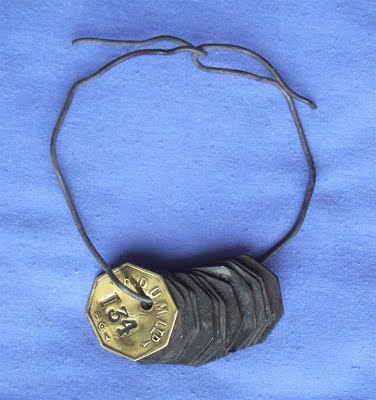
Each miner had his own round tally that he removed from a board when
clocking on. Before going underground he collected a hexagonal second
tally in numerical order. Hence, if a miner was first to arrive at start
of shift, his underground tally would be No. 1, ensuring that he would
be first up in the cage at the end of shift.
(Source: Personal communication in 2011 with Don Richardson, HDUM
electrician).
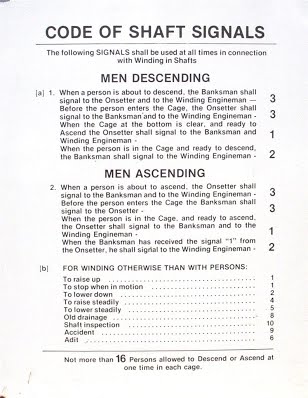
A bell signalling system is used in most mines. The sign above remains in
place at Olwyn Goch Shaft, Hendre
(Click image to enlarge, then BACK button to return)
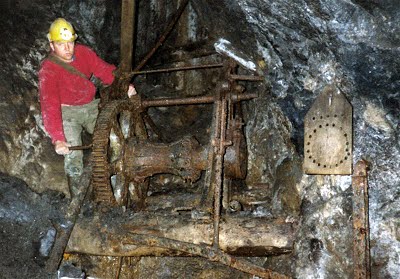
Great Halkyn Lode (Rhosesmor). A hand winch and counting board (about
1920) situated 200 feet above the level of the Halkyn Tunnel, at the top
of a steep incline. The winch was used for lowering ore down to the Halkyn
Tunnel below. The counting board is capable of recording up to 100 loads.
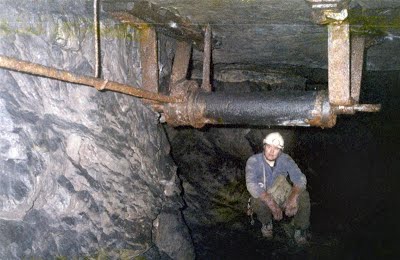
Roof-mounted winch in high workings of Westminster (or possibly Dixon's)
Lode, Rhosesmor
Photo by Les Walker
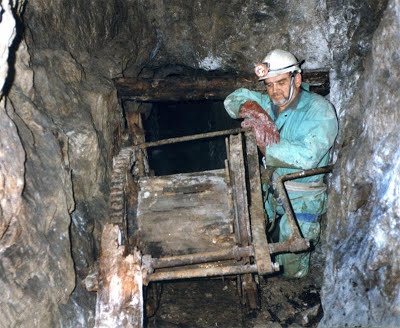
North Hendre Flat workings. This 1880s winch was originally mounted at
head height, but now lies where it has fallen.
It lies in the deepest area of the flat workings and is thought to have
been used for raising equipment up and down an inclined passage in
response to fluctuating water levels.
The Halkyn Tunnel was eventually driven past the area and a branch
passage was driven west to drain these workings.
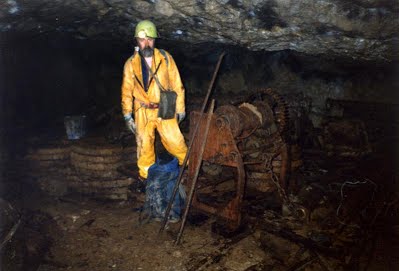
Winch lying at the bottom of Lewis's Shaft, Halkyn.
Note the piles of cheese-weights used for tensioning the shaft cage
guide-wires.
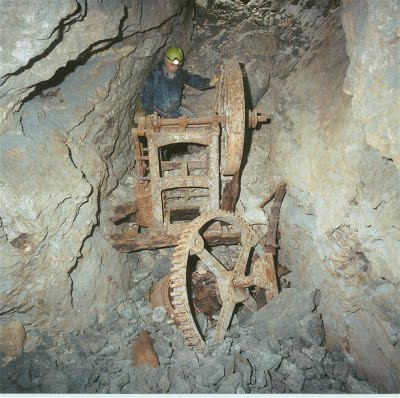
1870's compressed-air driven winch in Hendre flat workings.
Manufactured by Booth's of Liverpool
Photo by Paul Deakin
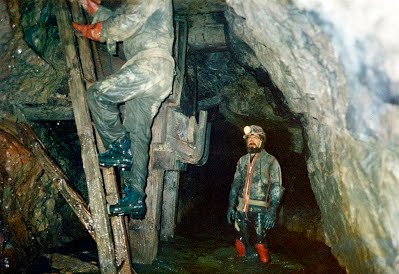
Ore shute and ladder on Llyn-y-pandy Lode. Most lodes had identical ore
shutes and ladders. Wagons would be positioned beneath the shute allowing
ore and rock to be released from the shute by raising a piece of timber.
The shutes were normally constructed at the lowest parts of a lode so that
ore could be easily taken away by wagon via the main Milwr Tunnel.
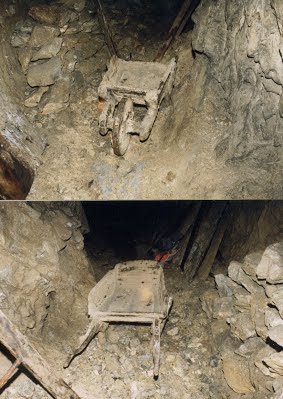
Wooden wheel-barrow in workings under Rhosesmor.
Photo by Dave Merchant
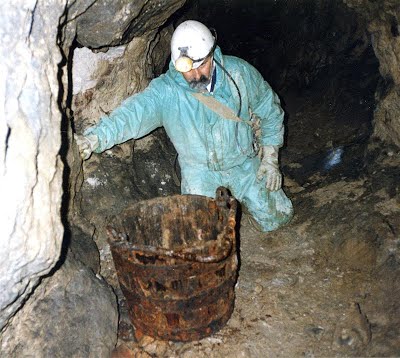
1880s wooden, iron-banded kibble in North Hendre flat workings.
Kibbles in later years were normally made entirely of iron or steel.
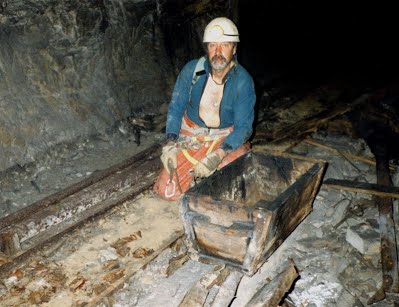
Ore box in Powell's Lode, Rhosesmor, on a branch of the Halkyn Tunnel.
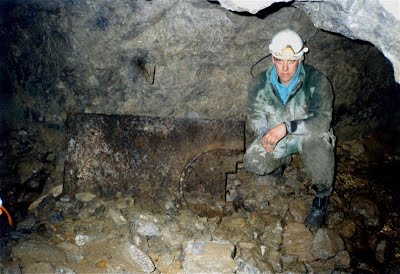
Resting on its side, a wagon turn-plate below Hendre flat workings.
Miners rotated mine wagons by pushing them round on this plate to
negotiate sharp bends or at passage junctions where angles were too
sharp for rails.
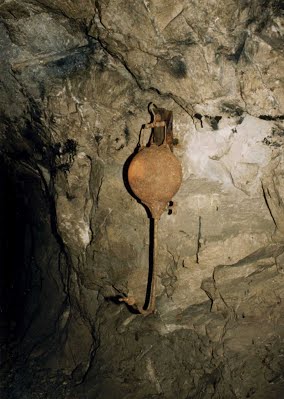
This may be the only lamp of its type to be found in a North Wales mine.
It is a naphtha flare lamp; naphtha being a byproduct of coal gas
manufacture. The lamp was patented in 1848. They were very popular on
market stalls and fairgrounds, producing a distinctive glare. There was
no wick; the burner was heated by the flame, as in Tilley lamps or
Primus stoves. Presumably they were unsuitable for underground use with
their long fragile pipe (Information courtesy of Chris Williams in
2014).
It can be seen today in a passage on the Great Halkyn Lode, driven
around 1908.
Photo by Dave Merchant

Water barrels at the level of the Halkyn Tunnel, Powell's Lode, Rhosesmor
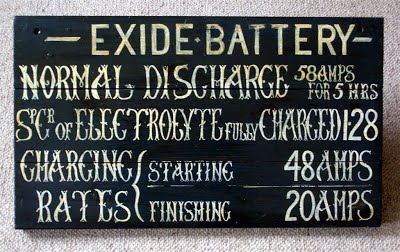
Restored sign originally displayed underground at Olwyn Goch Shaft loco
battery charging bay.
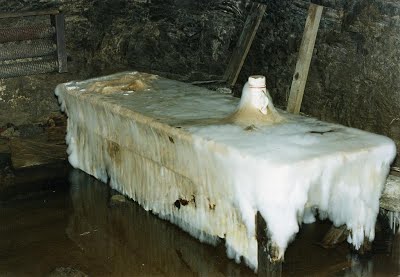
Fungal 'tablecloth' growing from the tea urn left by the last miners the
day the mine closed in 1987
The table was soon entirely devoured by the fungus
Photo: Barry Johnston
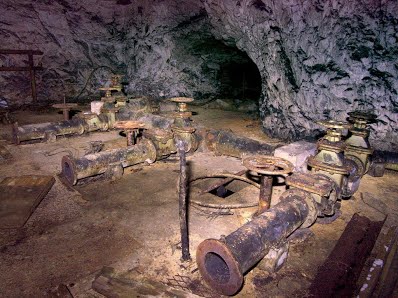
Erw Felin pump chamber; located just beside the Milwr Tunnel below
Rhydymwyn
Water was pumped up to surface from this chamber, then chanelled by pipe
accross the River Alyn, to supply the 'secret' govenmental factory 400
feet above.
Water pipes were installed in Erw Felin shaft which lies at the end of a
short passage at the back of the photo. It is now filled and lies
beneath a housing development. The shaft originally worked the Erw Felin
vein, which was neither productive nor extensive.
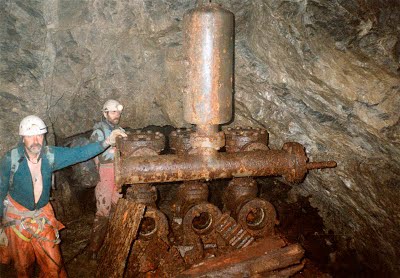
Triple throw ram pump at the bottom of Batter's Shaft, Rhosesmor
(beneath the Tiger Tim factory).
This was used to pump water up to surface where water was scarce, for
ore processing
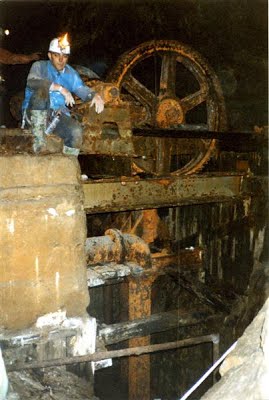
1908 pump close to the Great Halkyn Lode, Halkyn.
Another similar pump lies nearby. Both were used to pump water up into
the Halkyn Tunnel to allow deeper mining, in the days before the Milwr
Tunnel drained the area.
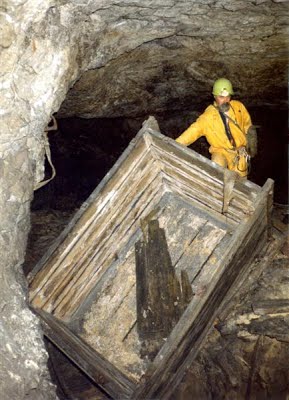
Timber water butt, 1920s. This has now collapsed into workings below and
has disintegrated.
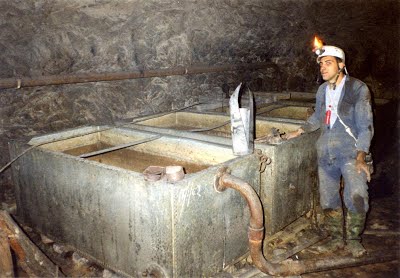
Galvanised water butts, 1930s. These remain in as good a condition as
the day they were made... almost.
They provided water for drilling, crucial in dampening down the
potentially harmful silica dust produced when drilling in limestone.
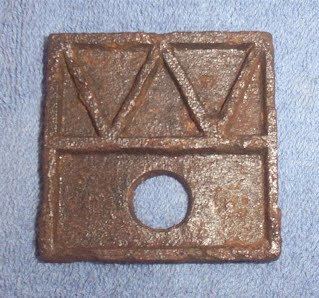
Shown as "W tablet" on old mine plans, several of these 2" square iron
plates marked the underground limit of the Duke of Westminsters mineral
boundary on the east end of the Great Halkyn Lode, just to the north of
Rhosesmor.
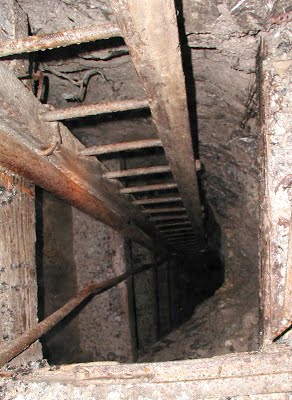
1930s timber ladder, typical of many that are scattered
throughout the workings.
Photo: Dave Merchant
Please get in touch to add photos of any artefacts on this page.
|






















